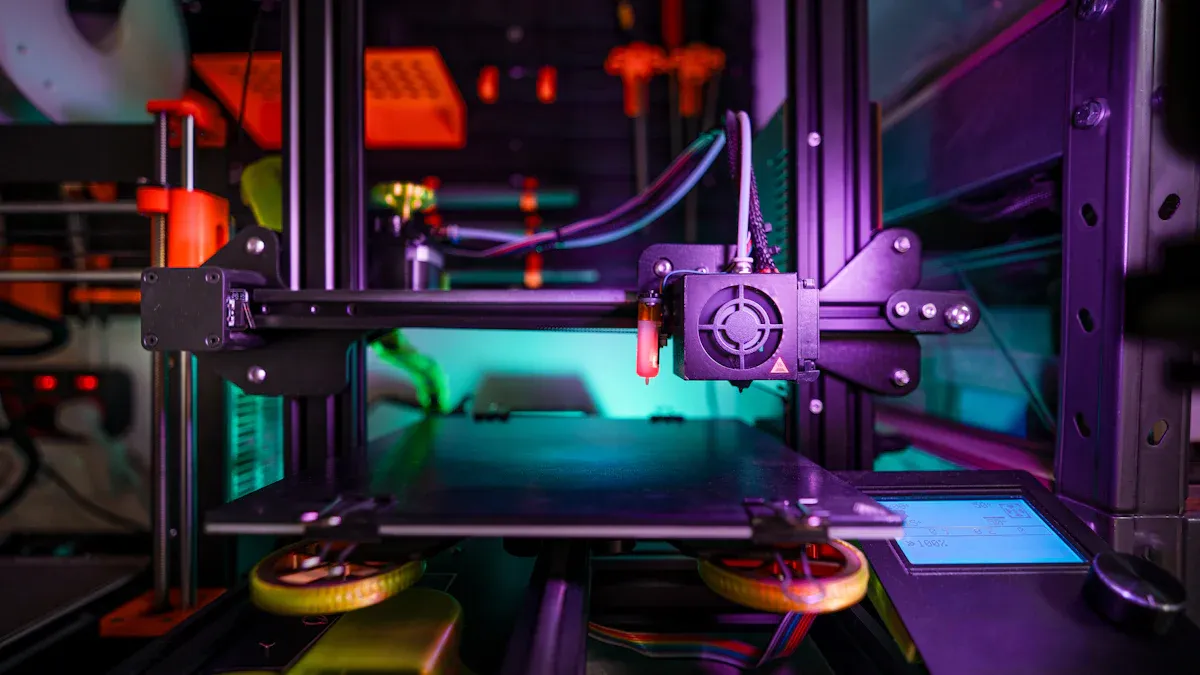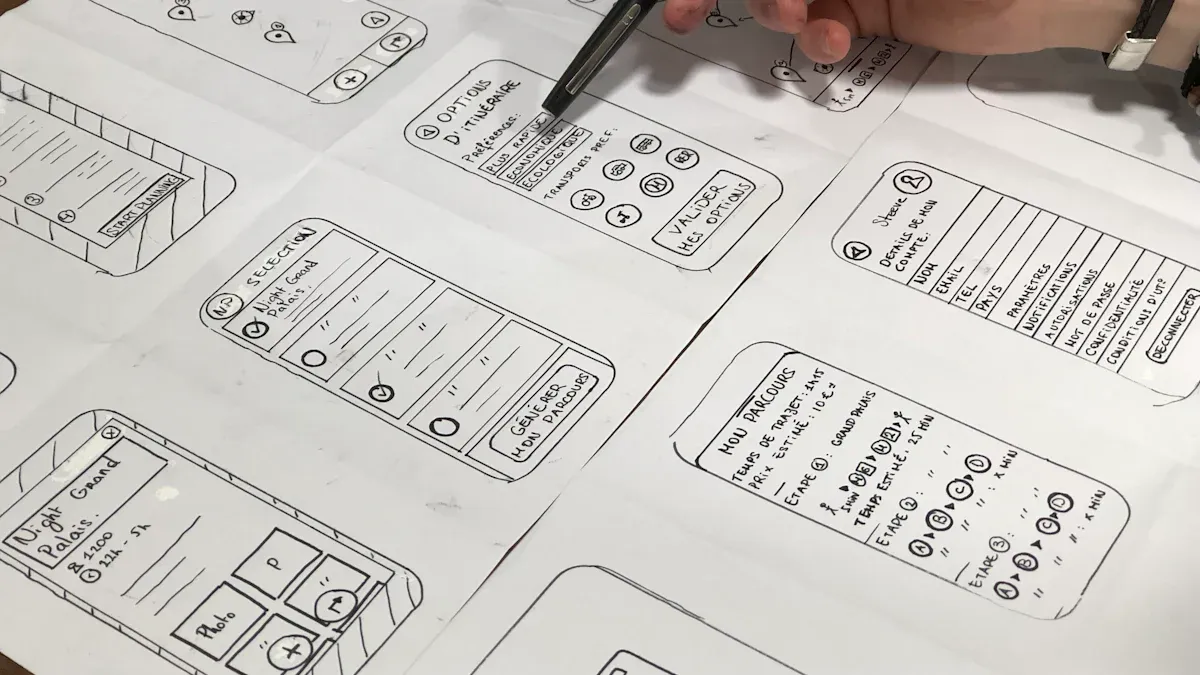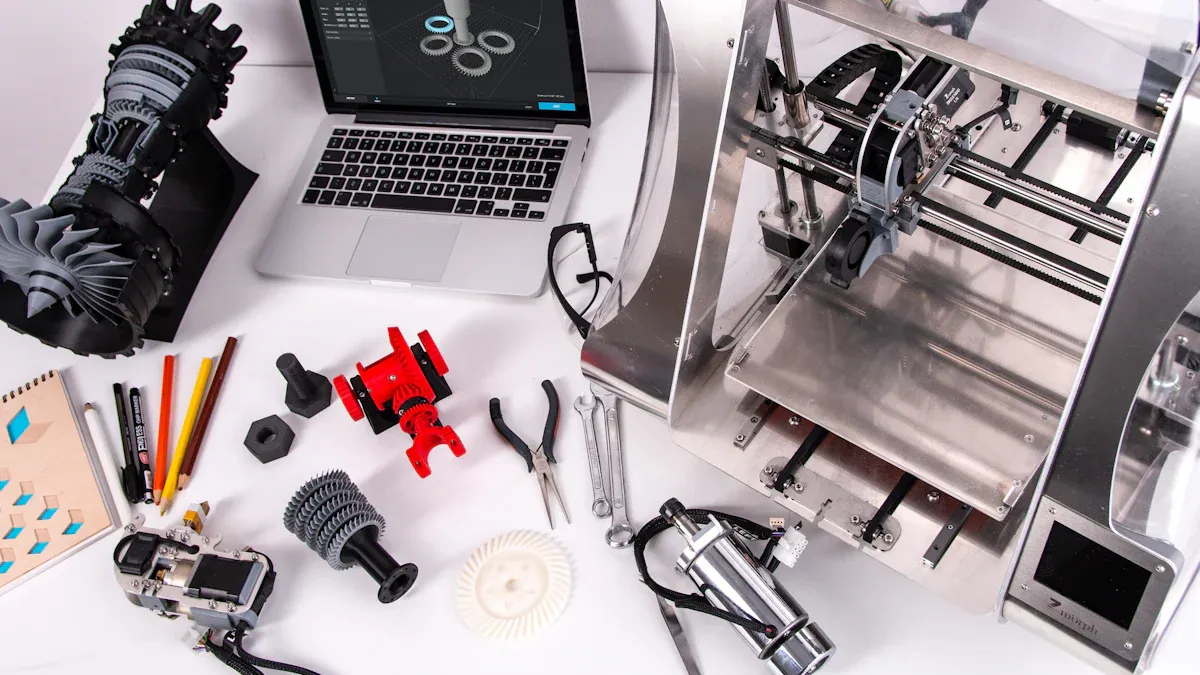
Choosing between injection molding and 3D printing for prototyping depends on your specific needs. Each method offers unique advantages. Injection molding works best for high-volume production where consistency is critical. On the other hand, 3D printing, a form of additive manufacturing, excels at creating low-volume, intricate designs with minimal setup costs. For example, 3D printing is often preferred for small to medium-sized parts due to its flexibility and speed in producing prototypes. However, injection molding becomes more cost-effective when producing over 10,000 units, as the initial tooling cost is spread across a larger volume. Understanding your project’s volume, design complexity, and budget will help you make the right choice.
Injection molding involves creating parts by injecting molten material into a mold. You start by designing a mold, typically made from metal, which defines the shape of the final product. The process begins with heating plastic or another material until it melts. This molten material is then injected into the mold cavity under high pressure. Once the material cools and solidifies, the mold opens, and the part is ejected.
The process relies on precise settings to ensure quality. For instance, hold pressure forces more material into the mold, increasing density and preventing defects like voids. Similarly, selecting the right fill speed, as shown in the Rheology Curve Chart, ensures uniform molecular orientation, improving part quality. Injection molding is ideal for producing large quantities of identical parts with tight tolerances and excellent surface finishes.
Additive manufacturing, commonly known as 3D printing, builds parts layer by layer. You begin by designing the part using specialized software. After finalizing the design, you plan the build by setting the part orientation and printer parameters. The printer then creates the part by depositing material layer by layer, which can take anywhere from a few hours to several days, depending on the complexity.
Once the printing is complete, you may need to clean and postprocess the part. This could involve removing support structures or smoothing surfaces. Additional finishing steps, such as painting or polishing, might also be required. Finally, you inspect the part to ensure it meets the desired specifications. Additive manufacturing offers unmatched design flexibility, allowing you to modify designs without the need for new molds.
Both injection molding and additive manufacturing play crucial roles in prototyping. Injection molding is best suited for high-volume production runs, such as creating over 100 parts with consistent quality. For example, manufacturers use injection molding to produce seat belt clamps in cars, where thermal conductivity in the mold materials enhances productivity.
On the other hand, additive manufacturing excels in early-stage prototyping or when you need fewer than 100 parts. It allows you to test complex designs quickly and cost-effectively. For instance, 3D printing is ideal for creating intricate prototypes that require frequent design changes. By choosing the right method, you can optimize your prototyping process based on your project’s needs.

When it comes to production speed, injection molding often outpaces 3D printing, especially for high-volume production. Once the mold is created, injection molding can produce thousands of identical parts in a matter of hours. This makes it ideal for projects requiring rapid prototyping or mass customization. For example, injection molded parts like bottle caps or automotive components can be manufactured at incredible speeds.
On the other hand, 3D printing is slower due to its layer-by-layer approach. Printing a single part can take several hours or even days, depending on its size and complexity. However, 3D printing shines in low-volume production, where setup time is minimal. If you need a prototype quickly without investing in tooling, additive manufacturing offers a faster turnaround for small batches.
Tip: If your project demands high production speed for large quantities, injection molding is the better choice. For low-volume production or intricate designs, 3D printing provides greater flexibility.
Cost plays a significant role in choosing between 3D printing and injection molding. Injection molding requires upfront investment in tooling, which can be expensive. However, this cost becomes negligible when spread across large production volumes. For example, prototype injection molding becomes cost-effective when producing thousands of units.
In contrast, 3D printing eliminates tooling costs, making it more affordable for low-volume production. Yet, industry reports highlight that 3D printing can become expensive for higher volumes due to longer build times and post-processing requirements. If your prototyping needs involve fewer than 100 parts, 3D printing offers a cost-effective solution. For larger quantities, injection molding remains the economical choice.
Note: Consider your production volume carefully. Injection molding is cost-efficient for large-scale projects, while 3D printing is better suited for smaller runs.
Material options and design flexibility differ significantly between injection molding and additive manufacturing. Injection molding supports a broad range of materials, including plastics, metals, and composites. These materials offer excellent strength and durability, making them ideal for functional prototypes. However, injection molding limits design flexibility, especially for complex geometries.
Additive manufacturing, on the other hand, excels in customization and intricate designs. It allows you to create prototypes with unique geometries that would be impossible with traditional methods. While 3D printing offers significant design flexibility, certain configurations may lack the strength of injection molded parts.
| Manufacturing Method | Material Options | Design Flexibility |
|---|---|---|
| Injection Molding | Broad range of materials with excellent strength | Limited in design flexibility, especially for complex shapes |
| Additive Manufacturing | Suitable for intricate designs and unique geometries | Significant design flexibility, but may have part strength limitations in certain configurations |
Tip: If your prototype requires strong materials and consistent quality, injection molding is the way to go. For complex geometries and creative designs, 3D printing offers unmatched flexibility.
When evaluating prototyping methods, part quality and strength are critical factors. Both injection molding and 3D printing offer unique advantages in this area, but their suitability depends on your specific requirements.
Injection molding produces parts with exceptional strength and durability. The process uses high-pressure injection to fill molds completely, resulting in dense and uniform parts. This makes injection molded parts ideal for functional prototypes that must withstand mechanical stress or harsh environments. For example, industries like automotive and aerospace rely on injection molding to create components such as brackets and housings. These parts maintain consistent quality across large production runs, ensuring reliability in demanding applications.
In contrast, 3D-printed prototypes often excel in design complexity but may fall short in strength compared to injection molded parts. The layer-by-layer construction of 3D printing can create weak points, especially in load-bearing applications. However, advancements in additive manufacturing have improved material options and printing techniques. Today, you can choose from high-performance materials like carbon fiber-reinforced polymers or metal powders to enhance the strength of 3D-printed parts. While these materials improve durability, they may still not match the structural integrity of parts produced through prototype injection molding.
Surface finish also plays a significant role in part quality. Injection molding delivers smooth, polished surfaces straight out of the mold, reducing the need for post-processing. This is particularly beneficial when creating prototypes for consumer products, where aesthetics matter. On the other hand, 3D printing often requires additional steps like sanding or coating to achieve a comparable finish. These extra steps can increase production time and cost, especially for intricate designs.
Tip: If your prototype demands high strength and a flawless surface finish, injection molding is the better choice. For prototypes with complex geometries or lower strength requirements, 3D printing offers greater flexibility.
Injection molding is the best choice when you need high-volume production with consistent quality. This method works well for creating production-ready prototype parts that require tight tolerances and durability. For example, in the automotive industry, injection molding is used to produce components like advanced braking system parts. These parts demand exceptional strength and dimensional accuracy. By using high-performance polymers and optimized mold designs, manufacturers can achieve faster production cycles and meet strict quality standards.
If your project involves a large production volume, injection molding becomes more cost-effective. Although the initial tooling cost is high, it spreads across thousands of units, reducing the cost per part. This makes it ideal for industries like consumer goods and automotive, where mass customization is essential. Additionally, injection molding supports a wide range of materials, allowing you to choose the best option for your prototype's strength and functionality.
Tip: Use injection molding when your prototype requires high strength, a flawless surface finish, and consistent quality across large quantities.
Additive manufacturing, or 3D printing, is perfect for low-volume production and customized designs. This method allows you to create complex geometries that traditional manufacturing methods cannot achieve. For instance, in aerospace, a fuel injector previously made of 20 parts can now be 3D printed as a single component. This reduces weight, improves durability, and eliminates assembly time.
You should consider additive manufacturing for prototyping when speed and flexibility are critical. It enables rapid prototyping, allowing you to test and refine designs quickly without the need for expensive molds. A consumer electronics company, for example, can use 3D printing to create prototypes of product enclosures. This helps test form, fit, and function before committing to costly injection molding.
Additive manufacturing for prototyping also excels in material selection and design capabilities. You can use advanced materials like carbon fiber-reinforced polymers to enhance strength while maintaining lightweight properties. This makes it a great option for industries like automotive and aerospace, where performance optimization is key.
Note: Choose additive manufacturing when your project requires low-volume production, quick turnaround times, and high design flexibility.

Recent advancements in injection molding technology are transforming the prototyping process. Real-time monitoring systems now track critical parameters during production, ensuring consistent quality and improving efficiency. Predictive maintenance strategies also enhance machine performance by identifying potential issues before they cause downtime. These innovations allow you to maintain production speed while reducing errors.
Automation has further revolutionized injection molding. Automated systems increase production rates and minimize human error, making the process faster and more reliable. For example, software for automated machines enables remote operation, ensuring continuous production even when you’re off-site. Additionally, micro injection molding now supports the creation of intricate small parts, which is essential for industries like electronics and medical devices.
Multi-material injection molding is another breakthrough. This technique allows you to combine different materials in a single part, enhancing design possibilities. By integrating 3D printing with injection molding, you can also achieve rapid prototyping and customization, reducing the time needed to bring your ideas to life.
Additive manufacturing continues to evolve, offering exciting possibilities for prototyping. Researchers are developing innovative materials, such as carbon fiber-reinforced polymers and metal powders, to improve the strength and durability of 3D-printed parts. These materials expand your options for creating functional prototypes that meet demanding performance standards.
Emerging technologies like AI and cloud computing are also enhancing additive manufacturing. AI-powered tools can generate design elements and predict user behavior, helping you refine your prototypes more efficiently. Meanwhile, cloud-based platforms allow you to collaborate with team members in real time, speeding up the design process.
The rise of augmented reality (AR) and virtual reality (VR) technologies is another game-changer. These tools enable you to visualize and interact with your prototypes in a virtual environment, making it easier to identify and address design flaws. This trend is driving demand for interactive prototyping solutions that prioritize user experience.
Combining injection molding and additive manufacturing offers a powerful hybrid approach to prototyping. You can use 3D printing to create initial concept models quickly and switch to injection molding for refined prototypes. This method accelerates the product development cycle, allowing you to bring products to market faster.
For example, Alpine utilized Nexa3D’s XiP desktop 3D printer in the Freeform Injection Molding (FIM) process to produce high-performance parts. This approach enabled rapid prototyping of complex geometries, reducing the need for significant tooling investments. By leveraging both methods, you can test designs thoroughly before committing to full-scale production.
Hybrid prototyping also supports cost management. 3D printing lowers the initial investment in molds, while injection molding ensures that your prototypes meet performance standards. This versatility allows you to test a wide range of materials and validate your designs effectively.
Tip: Consider a hybrid approach if you want to balance speed, cost, and quality in your prototyping process.
Injection molding and 3D printing offer distinct advantages for prototyping. Injection molding works best for high-volume production and late-stage prototypes that require durability and precision. On the other hand, 3D printing excels in creating low-volume, early-stage prototypes with intricate designs.
Key Takeaway: Your choice depends on your project’s needs. Consider factors like production volume, design complexity, and budget. By evaluating these, you can select the method that aligns with your goals and ensures the success of your prototype.
Injection molding is best for high-volume production with consistent quality. 3D printing, however, excels in creating low-volume, complex designs quickly and affordably. Your choice depends on your project’s needs.
Yes, you can. Many manufacturers use 3D printing for initial designs and injection molding for refined prototypes. This hybrid approach speeds up development and reduces costs.
Yes, it is. Prototyping with additive manufacturing allows you to create functional prototypes using advanced materials like carbon fiber-reinforced polymers. However, injection molding may offer better strength for demanding applications.
Injection molding supports a wide range of materials, including plastics and metals. 3D printing offers fewer options but excels in creating intricate designs with unique materials like metal powders or composites.
Injection molding is faster for high-volume production once the mold is ready. 3D printing, however, offers quicker turnaround times for low-volume prototypes since it doesn’t require tooling.